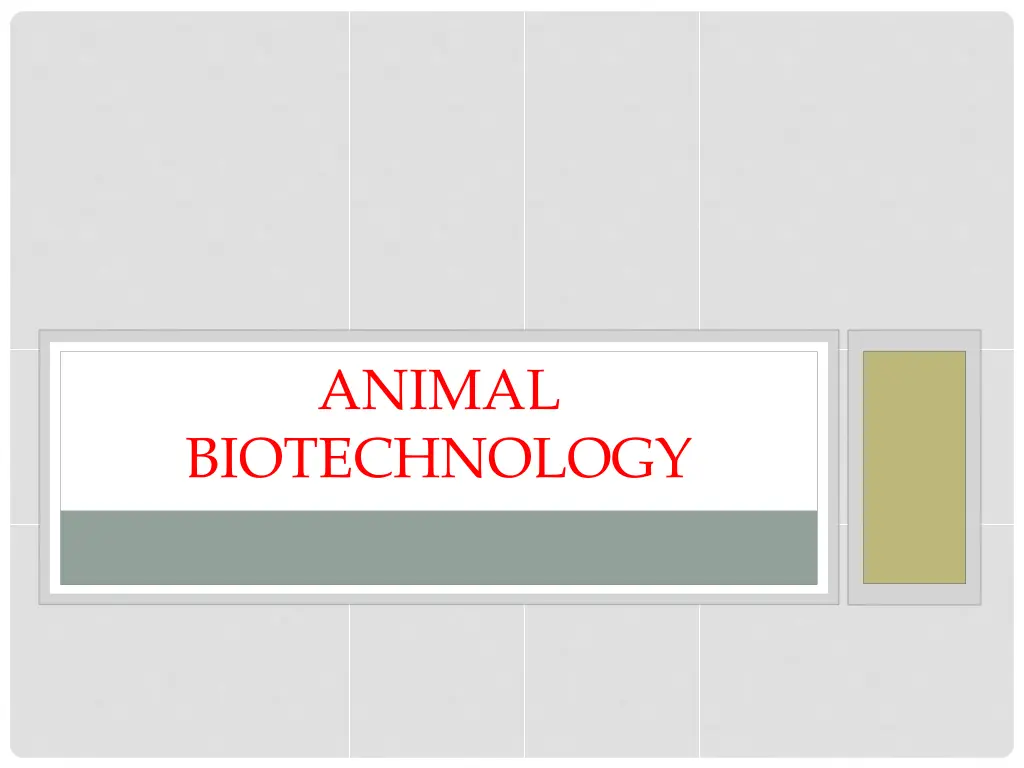
Advancing Animal Biotechnology: Techniques and Applications
Explore the diverse applications of animal biotechnology, from animal tissue culture for drug testing and cancer research to the production of vaccines through virology and the utilization of stem cells for regenerative medicine. Discover the significance of tissue culture in studying basic cell biology and toxicity testing, as well as the extraction of drugs and chemicals from animals. Uncover the potential of genetic engineering in producing commercial proteins and gene therapy.
Download Presentation

Please find below an Image/Link to download the presentation.
The content on the website is provided AS IS for your information and personal use only. It may not be sold, licensed, or shared on other websites without obtaining consent from the author. If you encounter any issues during the download, it is possible that the publisher has removed the file from their server.
You are allowed to download the files provided on this website for personal or commercial use, subject to the condition that they are used lawfully. All files are the property of their respective owners.
The content on the website is provided AS IS for your information and personal use only. It may not be sold, licensed, or shared on other websites without obtaining consent from the author.
E N D
Presentation Transcript
ANIMAL BIOTECHNOLOGY
ANIMAL BIOTECHNOLOGY TECHNIQUES 1-animal tissue culture 2-drugs and chemicals from animals 3- stem cells 4- transgenic animal
ANIMAL TISSUE CULTURE Why is cell culture used for? Areas where cell culture technology is currently playing a major role. Model systems for Studying basic cell biology, interactions between disease causing agents and cells, effects of drugs on cells, process and triggering of aging & nutritional studies Toxicity testing Study the effects of new drugs Cancer research Study the function of various chemicals, virus & radiation to convert normal cultured cells to cancerous cells
Virology Cultivation of virus for vaccine production, also used to study there infectious cycle. Genetic Engineering Production of commercial proteins, large scale production of viruses for use in vaccine production e.g. polio, rabies, chicken pox, hepatitis B & measles Gene therapy Cells having a functional gene can be replaced to cells which are having non-functional gene
TISSUE CULTURE In vitro cultivation of organs, tissues & cells at defined temperature using an incubator & supplemented with a medium containing cell nutrients & growth factors is collectively known as tissue culture Different types of cell grown in culture includes connective tissue elements such as fibroblasts, skeletal tissue, cardiac, epithelial tissue (liver, breast, skin, kidney) and many different types of tumor cells.
DRUGS AND CHEMICALS FROM ANIMALS 1-cantheridine 2-hirudin>>>>> Hirudo medicinalis 3-liver oil>>>> shark( A, D) 4-snake venoms>>>>>black cobra 5-ergotamin >>>>> ergot
STEM CELLS Stem cells are undifferentiated biological cells that can differentiate into specialized cells and can divide (through mitosis) to produce more stem cells. They are found in multicellular organisms. In mammals, there are two broad types of stem cells: embryonic stem cells, which are isolated from the inner cell mass of blastocysts, and adult stem cells, which are found in various tissues. Three important functions: Plasticity: Potential to change into other cell types like nerve cells Homing: To travel to the site of tissue damage Engraftment: To unite with other tissues 1. 2. 3.
There are three known accessible sources of autologous adult stem cells in humans: 1.Bone marrow, which requires extraction by harvesting, that is, drilling into bone (typically the femur or iliac crest). 2.Adipose tissue (lipid cells), which requires extraction by liposuction. 3.Blood
Adult stem cells are frequently used in medical therapies, for example in bone marrow transplantation Embryonic Stem cells can also be taken from umbilical cord blood just after birth
STEM CELL PROPERTIES The classical definition of a stem cell requires that it possess two properties: Self-renewal: the ability to go through numerous cycles of cell division while maintaining the undifferentiated state. Potency: the capacity to differentiate into specialized cell types. Cell potency is a cell's ability to differentiate into other cell types
1- Totipotency is the ability of a single cell to divide and produce all of the differentiated cells in an organism. Embryonic cells within the first couple of cell divisions after fertilization are the only cells that are totipotent. Totipotent stem cells have the potential to create an entire organism and are often considered the 'master' cells 2- Pluripotent cells can give rise to all of the cell types that make up the body The difference between totipotent and pluripotent cells is only that totipotent cells can give rise to both the placenta and the embryo.
STEM CELL APPLICATIONS 1- The main application of stem cells is still to replace damaged, diseased or dead cells. Once implanted, a stem cell can differentiate into the correct cell type, and form natural connections with the surrounding tissue, which is very important in neurodegenerative diseases such as Parkinson's and Alzheimer's. 2- Adult blood stem cells have been used to treat hematologic (blood) cancers. Adult blood-forming stem cells from bone marrow have been used in transplants for over 30 years. The stem cells of the matched donor are purified, and the patient's bone marrow is then destroyed by radiation and reconstituted with the stem cell graft.
3- Stem cells can be modified to produce enzymes or factors, such as insulin, before being transplanted into the body. 4-- Stem cells can also be modified to resist certain infections. For example, studies are underway to create stem cells resistant to HIV. Once implanted, these stem cells would repopulate the diseased immune system of AIDS patients with cells resistant to the disease. 5- Stem cells may also be useful in tissue-engineering applications, such as the production of complete organs, including heart, liver, kidneys, eyes or even parts of the brain.
PLURIPOTENT STEM CELLS MORE POTENTIAL TO BECOME ANY TYPE OF CELL
